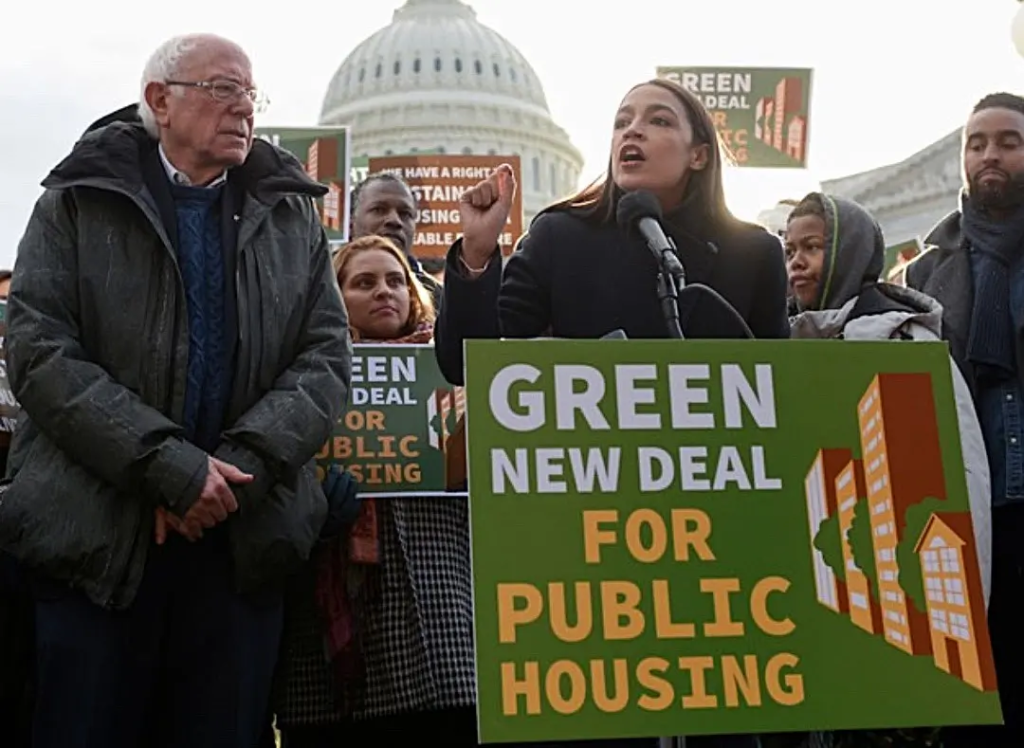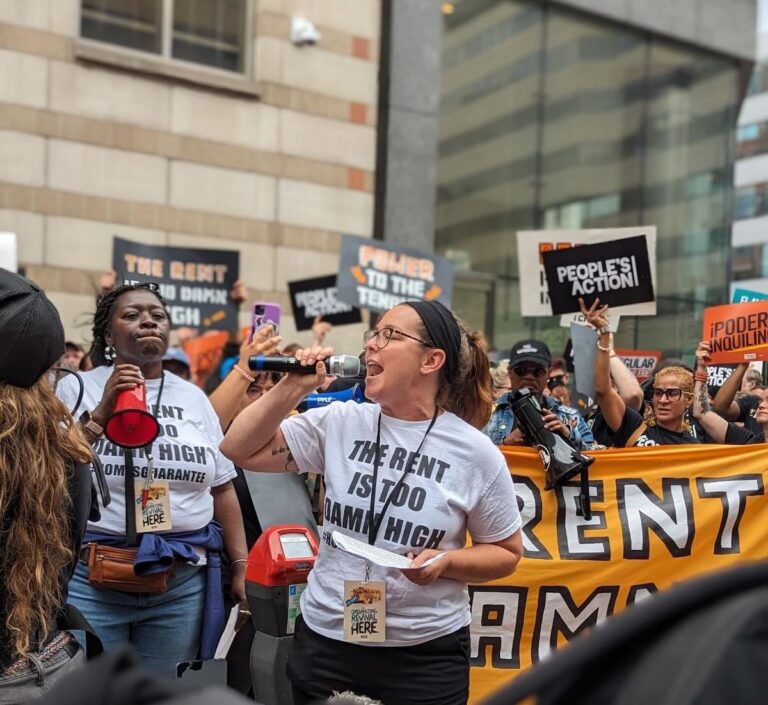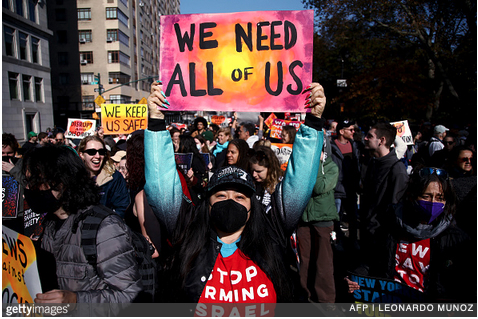History shows that mobilizing around aspirational goals, even if they are out of reach at the moment, can have real value for social movements.
By Fran Quigley for Waging Nonviolence
The law school clinic that I direct at Indiana University represents tenants in local eviction courts. Our client Tanya needed pay-up-front emergency dental surgery, so she did not have enough money left for her rent. James’ family has endured feces-filled water backing up in their laundry room, mold on the walls and a caved-in ceiling, while their corporate landlord has ignored their maintenance calls. Beatrice’s family wants to keep her daughter in the school district they like, but the landlord who just bought her building has announced a $300 per month rent hike.
All of these households, and virtually all of the people we see in eviction court, qualify for federally-subsidized housing. But few receive it, with three-quarters of eligible households going without due to underfunding of the program and deterioration of the public housing stock. So Tanya, James, Beatrice and all the others lined up in eviction court are among the 3.6 million households facing eviction each year, and the seven million households that Census Bureau shows as behind on their rent.
There are proposals to change all this. The Green New Deal for Public Housing Act, sponsored by Sen. Bernie Sanders and Rep. Alexandria Ocasio-Cortez, would devote up to $234 billion over 10 years to transition U.S. public housing to energy-efficient units. It would also remedy the shameful maintenance backlog that leaves thousands of units uninhabitable and repeal the loathsome Faircloth Amendment that blocks the construction of new public housing.
Also, a new National Tenants Bill of Rights, drafted by the Tenant Union Federation, the National Housing Law Project and the National Low Income Housing Coalition guarantees stable rents and healthy, safe homes. It requires evictions to be for just cause only, prohibits discriminatory and expensive rental applications, and protects tenants’ right to organize.
The biggest swing is taken by Rep. Ilhan Omar’s Homes for All Act, which would both repeal the Faircloth Amendment and devote a full $1 trillion to build over 10 million public and permanently affordable housing units.
Yet no serious observer of the current U.S. political climate expects these ambitious proposals to become law in the near future. Neither the Green New Deal for Public Housing nor the Homes for All Act have even received a hearing in Congress, much less a vote. The Tenants Bill of Rights contemplates sweeping federal-level rent control and comprehensive tenant protections, neither of which are on the near horizon.
All of which begs the question: For Tanya, James, Beatrice and millions of other housing-insecure Americans like them, what good do these proposals do? Maybe a lot.
Expanding the Overton Window
Social movement history, and the theories that try to explain it, suggest that bold plans like the Green New Deal for Public Housing, Tenants Bill of Rights, and the Homes for All Act serve an important purpose in movements’ growth.
Over two decades ago, sociologists Robert Benford and David Snow wrote a landmark American Sociological Review article about the central role that framing plays in a social movement. “Frames are developed and deployed to achieve a specific purpose — to recruit new members, to mobilize adherents, to acquire resources, and so forth,” Benford and Snow wrote. Plans that articulate the end goal of a movement serve an important role in the framing process. Benford and Snow and other social movement scholars highlight the importance of framing in the slavery abolition movement and the U.S. civil rights movement, where themes of immorality and human rights linked with the existing cultural values of the public that the movement activists were trying to persuade.
For aspirational housing proposals, both their titles and content fit into this framing model. The Green New Deal for Public Housing Act connects the often-vilified U.S. public housing system to both the legendary New Deal and the more recent but popular Green New Deal. The Tenants Bill of Rights unsubtly invokes the hallowed U.S. Constitution, and the Homes for All Act echoes the well-established and widely popular Medicare for All campaign.
The fact that these proposals do not seem to be on the verge of adoption anytime soon does not negate their value to the movement, according to the oft-discussed concept of the Overton Window. The Overton Window is based on the premise that elected officials dependent on winning popular elections will never adopt a policy unless it is within the range of options — or window, as it were — that enjoy broad support among the public.
For example, a trillion dollars in spending for public and subsidized housing may initially lie outside that window. But articles and social media discussion about Rep. Omar’s Homes for All bill may move that window to the point where, say, the $234 billion contemplated by the Green New Deal for Public Housing Act does not seem outlandish.
All this provides a movement opportunity, as Mark Engler and Paul Engler have written. “While insider politicians and lobbyists will focus their energies on haggling over policy options within the window of ‘sensible’ reform, outside advocates need not limit themselves to championing the most immediately pragmatic proposals,” they explain. “Instead, by holding up more substantive and visionary demands, they can win more in the long run by pushing the Overton Window in a direction more favorable to their politics.”

A recent powerful example of this movement strategy comes from the Black Lives Matter movement. Racial justice activists have not yet achieved police abolition, but they have created the space in many communities for reforms of police procedures and transfer of resources from law enforcement to mental health services.
Another is Occupy Wall Street, which did not realize its initial goals — like constitutional limits on corporate campaign spending or adoption of Medicare for All — but undeniably helped set the stage for the successful Fight for $15 movement and a leftward shift in the national Democrat Party.
Have a North Star and walk towards it
The Sunrise Movement’s bold demands centered in the Green New Deal had a direct impact on Joe Biden’s 2020 election climate plan. Noam Chomsky even said the Biden plan was “largely written by the Sunrise Movement.”
One of the Sunrise Movement’s co-founders, Will Lawrence, agrees that aiming high with the Green New Deal for Public Housing, Tenants Bill of Rights and the Homes for All Act can lead to substantive change.
How activists are making the right to housing a reality
Of course, these concessions by elites are symptoms of the movement’s impact, not the cause of it. Relentless canvassing, phone banking, one-on-one organizing and public demonstrations by tenant unions and other housing advocates have led to significant victories at the state and local levels on rent control, tenants’ rights and increased affordable housing investment. Those wins should not be too surprising, since polling shows housing as a human right, tenant protections and the Green New Deal for Public Housing are all strongly supported by the public.
A national victory is possible. We can see that future in Vienna, where half of the city’s residents live in high-quality public housing. In Singapore, a program of eminent domain in the 1960s claimed land that now is the site for attractive government-subsidized housing acclaimed as the best in the world. In the same era, Sweden’s “Million Homes Program” created an amount of affordable housing that would equate to more than 18 million homes in the U.S. today.
To reach that kind of future in the U.S., we first need to envision it. These bold housing proposals help us do just that.


